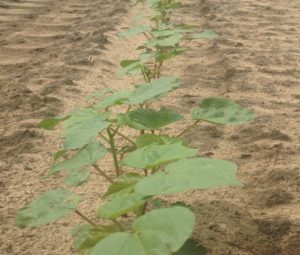by Seth Byrd, Assistant Professor & Extension Cotton Specialist, Lubbock, TX
As we near the time of the year when cotton planting will start in the High Plains and Rolling Plains region, it is always helpful to remind ourselves of early-season growth and development of cotton in order to start-off the season strong. Two of the primary drivers behind the growth of cotton, both at early growth stages and throughout the season, are water and temperature. While warm days certainly signal the onset of planting season, be careful to monitor overnight lows as even daytime highs of 90° can result in slow growth rates if overnight lows drop to 50° or less. Timing planting around optimal temperatures (high’s in the low to mid 80’s or higher, overnight lows in the 60’s or above) will ensure that the plant accumulates the needed daily heat units to achieve rapid growth and emergence. For additional information on soil temperature considerations see the publication “Soil Temperatures for Cotton Planting”.
Obviously moisture often drives planting decisions more so than temperature in West Texas, particularly for dryland producers. Although cotton doesn’t require much water for adequate growth early in the season, planting into moisture is recommended to ensure rapid germination and emergence. It is more beneficial from the seed’s perspective to be sowed into a moist seed bed where water can be readily absorbed, rather than into a dry seed bed and waiting for enough moisture to initiate germination. In dryland scenarios, the combination of soil moisture and ideal temperatures is rare. So, a balance must be met between these two factors to provide the best possible conditions for early season growth. The publication “How a Cotton Plant Grows” has a good section on seed germination and establishment.
Uniform emergence and rapid early season growth is not only critical to establishing a uniform stand, but these conditions will also help mitigate stresses the seedlings will be exposed to. Both herbicide injury from preemergence herbicides, in particular Caporal or Cotoran, and thrips feeding, can be detrimental to the growth of cotton seedlings, with the negative impacts of these magnified when present in combination with each other. Warm temperatures and adequate soil moisture promote rapid growth that aid in the plant’s ability to grow out of these stressed conditions, while cool temperatures prolong the amount of time the plants remain susceptible to thrips. Cotton is most susceptible at to thrips at early growth stages, from the cotyledon stage just after emergence to the 4-5 leaf stage. It is typically recommended to scout for thrips up to the 5 to 7 leaf stage to determine if an insecticide application is necessary. For more information on thrips damage and control see the “Cotton Insect Management Guide – Thrips”.
For more information on cotton planting considerations and early season growth, visit http://cotton.tamu.edu/.

Assistant Professor & Extension Specialist, Texas A&M AgriLife Extension Service
Lubbock, TX
806.746.6101
seth.byrd@ag.tamu.edu

